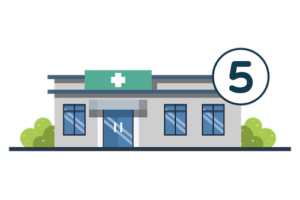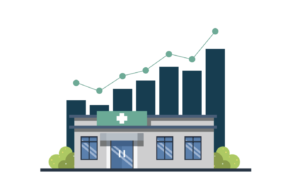Don’t Fall Behind: 3 Ways to Meet Baby Boomers’ Healthcare Demands
By Blakely Roth | August 17, 2023
Age is just a number for your older patients, as they continue to grow increasingly interested in adopting new technology. A sentiment from the Wall Street Journal shares that individuals 50+ spent an average of $912 on technology last year, up from $394 in 2019.
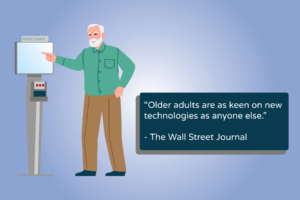
This sentiment is supported by additional surveys, which share that nearly 90% of patients state that “Ease of Access” is a major factor when choosing healthcare providers.
Going on, The Wall Steet Journal article notes that there must be a practical reason for elderly US residents to adopt new technology. Healthcare management is often one a practical, top priority for aging and older populations. Baby boomers and older US adults want to take ownership of their healthcare needs. This involvement is especially crucial when it comes to data accuracy and security, financial responsibility and booking appointments. Here are three ways to meet baby boomer healthcare demands and avoid falling behind the competition for patient revenue.
1. Scheduling: Provide the Access Aging Adults Want from Care Providers
For baby boomers and aging patients, scheduling plays a pivotal role in their healthcare journey, and today nearly 82% of patients prefer a provider who offers online scheduling. As US adults get older and need to see additional specialty providers, they’ll search and book online. If your practice doesn’t offer online scheduling, your practice will miss out on this growing patient base, reducing your ability to compete.
With the increasing adoption of technology, online patient scheduling software has become a vital component to a practice’s patient acquisition and retention strategy.
Offering 24/7 online scheduling provides the convenience and efficiency that all patients seek, including older generations. Online appointment booking platforms empower elderly patients to easily access and choose suitable time slots that align with their preferences and medical needs. By embracing digital scheduling, healthcare providers can cater to their patients’ demands for simplicity and flexibility, while also boosting patient acquisition and revenue growth. Using this approach practices are starting to bring in more patients than ever before.
Additionally, “seeing a practitioner quickly” continues to become a major challenge for patients of all ages. Consider offering a waitlist to help your patients see their providers faster, while you fill more scheduling gaps. See how you could use a waitlist to boost patient acquisition.
2. Patient Data Capture: Give Baby Boomers Ownership of Their Information & Ensure Security
By leveraging digital tools for data capture, you can provide older patients with a simple and secure way to manage their personal data and healthcare needs. According to a recent survey, 56% of patients expressed a general preference for more digital healthcare management options.
Simply by providing your patients with the option to update their data through self-registration kiosk or pre-check, you empower your patients to manage their information to ensure accuracy. Older patients, like baby boomers, may have recently moved, retired, updated their health insurance or made other lifestyle changes. By giving them the option to notify you of these changes, you empower them to engage in their healthcare experience and take ownership. While you can ask patients these questions face-to-face during check-in, self-registration technology has been shown to make the process more efficient for both the practice and the patient.
Mary Ann McNeill, Practice Manager at Cary Dermatology, recently shared how prompting patients to make demographic updates via patient check-in kiosks, versus face-to-face interactions, made a significant impact on patient data capture.
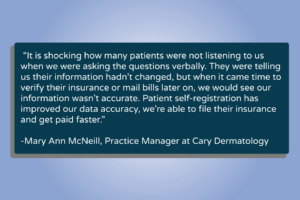
Beyond data management, when it comes to using technology, security is top of mind for older generations, according to the Wall Street Journal. Private, patient check-in kiosks that are backed up by the cloud and not on internal servers help you provide the security your patients require.
While technology benefits all generations, will your elderly patient population adopt this technology, or will they resort to checking in at the front desk? Hear the reaction Cary Dermatology saw after implementing self-registration kiosks.
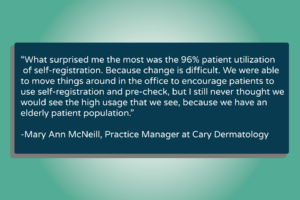
See how Cary Dermatology increased co-pay collections by 31% while also increasing data accuracy and improving billing processes.
Beyond accelerating cash flow and providing patients with ownership over their data, capturing data digitally opens a realm of possibilities for improving healthcare outcomes among the baby boomer population. See how you can personalize your patients’ experience through data.
3. Financial Transparency: Empower Informed Healthcare Decisions
For elderly patients, financial transparency is a crucial aspect of their healthcare experience. Nearly 90% of patients recently surveyed agree that healthcare providers should prioritize improving patient access to financial information. Meanwhile, 83% of patients want to see accurate information on out-of-pocket costs before receiving healthcare services.
By providing clear and accessible information about healthcare costs, billing and insurance coverage, healthcare providers can empower patients to make informed decisions about their treatment options. Transparent financial practices build trust and foster stronger patient-provider relationships and better patient reviews! Technology has been key to helping high-growth practices provide this transparency, without overburdening staff.
Through digital platforms, baby boomers and all patients can easily access and review their financial responsibility, reducing anxiety and uncertainty surrounding healthcare expenses. As a result, financial transparency enhances the overall healthcare journey, promoting a sense of control and security in managing their medical finances. One practice recently implemented a push-of-a-button approach to verify patient insurance, determine accurate estimates and send notifications to patients prior to their appointments. As a result, patient self-pay and point-of-service collections have increased for the practice.
Learn more about the cost-efficient estimations approach the practice implemented and read their story. See how you can implement a similar approach to empower all your patients, regardless of age, to make informed healthcare decisions — and boost cash flow while you’re at it!
Meet Patients Where They Are, Regardless of Age & Don’t Get Left Behind.
By focusing on these three areas, scheduling, patient data capture and financial transparency, healthcare providers can meet the demands of baby boomers who are seeking digital access and ownership of their healthcare at an increasing rate. At the same time, employ these strategies to boost patient acquisition and fuel faster time to revenue. See the 5 steps high-growth practices are taking to increase patient revenue and their ability to compete!
Recommended for you
Related Posts
How to Increase Dermatology Patients & Profits With an Online Scheduling Platform
Reading Time: 4 minutes By Chloe From Clearwave | October 21, 2024 Picture this: A patient notices an unusual mole after returning home from…
New From Clearwave Innovation Lab: Remaining Deductible & Clinical Intake Enhancements
Reading Time: 3 minutes By Blakely Roth | October 17, 2024 It’s that time again — see all the new and exiting product enhancements…
3 Tips For Using Self-Scheduling to Boost Patient Acquisition in Healthcare
Reading Time: 4 minutes By Chloe From Clearwave | October 7, 2024 In a time when convenience is king, healthcare practices are turning to…

